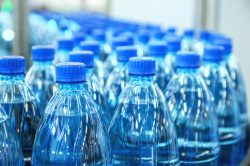 Plastic contamination in our water is a proven fact. Astonishingly, a study in 2018 unearthed an average of approximately 300 plastic particles in just one liter of water. However, this study primarily focused on microplastics, which are tiny fragments of plastic measuring less than 5 millimeters in length.
Plastic contamination in our water is a proven fact. Astonishingly, a study in 2018 unearthed an average of approximately 300 plastic particles in just one liter of water. However, this study primarily focused on microplastics, which are tiny fragments of plastic measuring less than 5 millimeters in length.
Now, researchers have delved even deeper into the issue by investigating nanoplastics. These minuscule particles, less than 1 micrometer in size, are incredibly smaller than the width of a human hair. Nanoplastics have been revealed to be a huge concern in bottled water.
Scientists have uncovered shocking levels of plastic fragments, with a staggering 10 to 100 times more than previously thought. Each liter of bottled water contains a jaw-dropping 240,000 detectable plastic fragments. This groundbreaking discovery was made by scientists using advanced laser technology to uncover the presence of nanoplastics.
Scientists examined three well-known bottled water brands sold in the United States. Although the brands were not disclosed, the researchers carefully analyzed the samples for seven different types of plastics. Using an advanced data-driven algorithm, they were able to make sense of the findings. Shockingly, the study revealed that each liter of water contained between 110,000 and 370,000 particles. Even more concerning, approximately 90% of these particles were nanoplastics, with the remaining being microplastics.
Microplastics can enter our bodies when we breathe, drink, and eat. Health officials have found that while our bodies can naturally eliminate most of these microplastics, some tiny particles can still linger. A recent study revealed that nanoplastics, which are even smaller than microplastics, may be even more harmful to our health. Their smaller size makes it easier for them to enter our bodies and potentially cause more damage.
The health risks of microscopic plastic particles are still uncertain. These hazards can arise from the particles themselves, the chemicals they consist of, and the formation of biofilms by microorganisms on the plastics. As these particles become smaller and reach the nano size, there is a possibility that they can enter the bloodstream and be transported to important organs.
In the United States, bottled water products are subject to strict regulation by the Food and Drug Administration (FDA). As part of these regulations, the water undergoes filtration to remove particles larger than one micron, which is equivalent to .00004” in size. This process ensures the quality and safety of the water consumed by the public. The FDA is currently conducting a thorough review of a recent study on nanoplastic in bottled water.
This research highlights the startling presence of plastics in our everyday drinking water.
To view the original scientific study click below:
Rapid single-particle chemical imaging of nanoplastics by SRS microscopy





